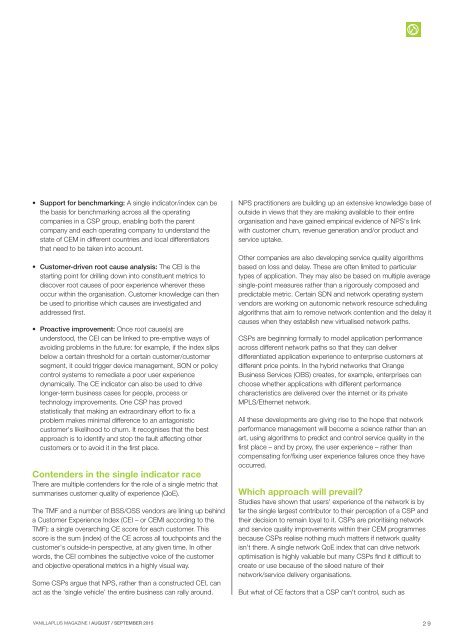CEM
1UBylUS
1UBylUS
Create successful ePaper yourself
Turn your PDF publications into a flip-book with our unique Google optimized e-Paper software.
• Support for benchmarking: A single indicator/index can be<br />
the basis for benchmarking across all the operating<br />
companies in a CSP group, enabling both the parent<br />
company and each operating company to understand the<br />
state of <strong>CEM</strong> in different countries and local differentiators<br />
that need to be taken into account.<br />
• Customer-driven root cause analysis: The CEI is the<br />
starting point for drilling down into constituent metrics to<br />
discover root causes of poor experience wherever these<br />
occur within the organisation. Customer knowledge can then<br />
be used to prioritise which causes are investigated and<br />
addressed first.<br />
• Proactive improvement: Once root cause(s) are<br />
understood, the CEI can be linked to pre-emptive ways of<br />
avoiding problems in the future: for example, if the index slips<br />
below a certain threshold for a certain customer/customer<br />
segment, it could trigger device management, SON or policy<br />
control systems to remediate a poor user experience<br />
dynamically. The CE indicator can also be used to drive<br />
longer-term business cases for people, process or<br />
technology improvements. One CSP has proved<br />
statistically that making an extraordinary effort to fix a<br />
problem makes minimal difference to an antagonistic<br />
customer's likelihood to churn. It recognises that the best<br />
approach is to identify and stop the fault affecting other<br />
customers or to avoid it in the first place.<br />
Contenders in the single indicator race<br />
There are multiple contenders for the role of a single metric that<br />
summarises customer quality of experience (QoE).<br />
The TMF and a number of BSS/OSS vendors are lining up behind<br />
a Customer Experience Index (CEI – or <strong>CEM</strong>I according to the<br />
TMF): a single overarching CE score for each customer. This<br />
score is the sum (index) of the CE across all touchpoints and the<br />
customer's outside-in perspective, at any given time. In other<br />
words, the CEI combines the subjective voice of the customer<br />
and objective operational metrics in a highly visual way.<br />
Some CSPs argue that NPS, rather than a constructed CEI, can<br />
act as the ‘single vehicle’ the entire business can rally around.<br />
NPS practitioners are building up an extensive knowledge base of<br />
outside in views that they are making available to their entire<br />
organisation and have gained empirical evidence of NPS's link<br />
with customer churn, revenue generation and/or product and<br />
service uptake.<br />
Other companies are also developing service quality algorithms<br />
based on loss and delay. These are often limited to particular<br />
types of application. They may also be based on multiple average<br />
single-point measures rather than a rigorously composed and<br />
predictable metric. Certain SDN and network operating system<br />
vendors are working on autonomic network resource scheduling<br />
algorithms that aim to remove network contention and the delay it<br />
causes when they establish new virtualised network paths.<br />
CSPs are beginning formally to model application performance<br />
across different network paths so that they can deliver<br />
differentiated application experience to enterprise customers at<br />
different price points. In the hybrid networks that Orange<br />
Business Services (OBS) creates, for example, enterprises can<br />
choose whether applications with different performance<br />
characteristics are delivered over the internet or its private<br />
MPLS/Ethernet network.<br />
All these developments are giving rise to the hope that network<br />
performance management will become a science rather than an<br />
art, using algorithms to predict and control service quality in the<br />
first place – and by proxy, the user experience – rather than<br />
compensating for/fixing user experience failures once they have<br />
occurred.<br />
Which approach will prevail?<br />
Studies have shown that users' experience of the network is by<br />
far the single largest contributor to their perception of a CSP and<br />
their decision to remain loyal to it. CSPs are prioritising network<br />
and service quality improvements within their <strong>CEM</strong> programmes<br />
because CSPs realise nothing much matters if network quality<br />
isn’t there. A single network QoE index that can drive network<br />
optimisation is highly valuable but many CSPs find it difficult to<br />
create or use because of the siloed nature of their<br />
network/service delivery organisations.<br />
But what of CE factors that a CSP can't control, such as<br />
VANILLAPLUS MAGAZINE I AUGUST / SEPTEMBER 2015<br />
29


